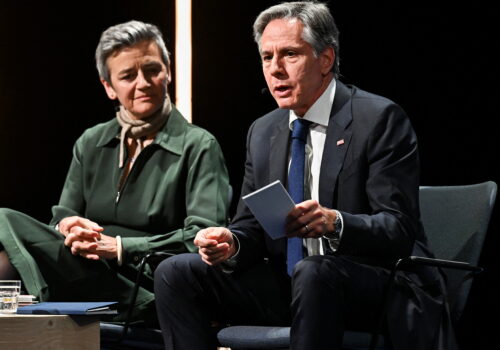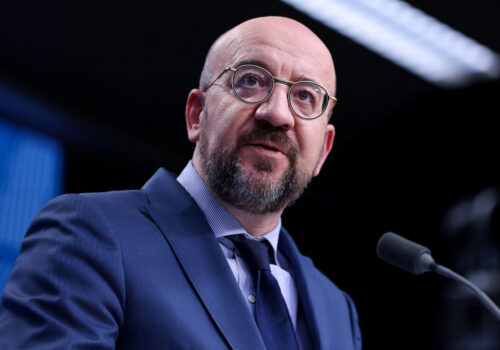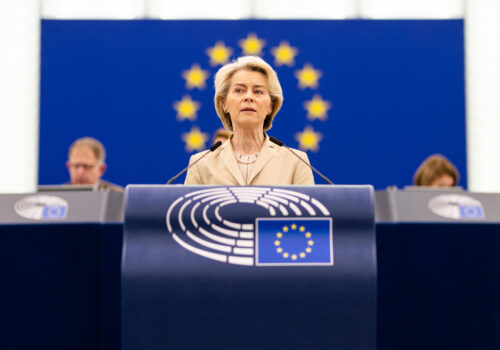Ursula von der Leyen set Europe’s ‘de-risking’ in motion. What’s the status one year later?
There are two speeches delivered by Europeans since the launch of Russia’s full-scale invasion of Ukraine that best encapsulate the complete rethinking of Europe’s strategy and outlook.
One was German Chancellor Olaf Scholz’s Zeitenwende speech three days following the 2022 invasion. It symbolized a change in Germany’s recognition of the need to prepare for a new era of confrontation—even conflict—on the continent.
Second was European Commission President Ursula von der Leyen’s speech on March 30, 2023. Warning of growing ties between Moscow and Beijing, she presented a new vision for Europe’s relationship with China, a country that, she argued, holds enormous economic and geopolitical leverage over Europe.
That must change, von der Leyen asserted. With the framing of de-risking, not decoupling, she outlined a future for Europe’s greater economic independence. Learning the lessons from Europe’s overreliance on cheap Russian energy, Europe’s dependence on China for critical materials used for the green transition and digital technologies could not stand.
Her speech was met with applause from many across the continent—and the White House. Some less enthusiastic European leaders and economists looked warily at Europe’s balance sheets and cautioned against a tougher line on China. Beijing was equal parts unamused and skeptical.
One year on, how real is Brussels’s de-risking in practice?
The state of de-risking is strong . . . on paper
Europe’s de-risking is a work in progress, but it is still progress. Speeches don’t translate into immediate policy change, least of all in Brussels, with its complex consensus- and compromise-based decision making. But at both the European Union (EU) and the member state level, de-risking has moved up the policy agenda.
At the EU level, the European Commission has grown increasingly proactive in strengthening Europe’s economic defenses against Chinese influence and leverage. In June 2023, the Commission published its Joint Communication on a European Economic Security Strategy. This strategy began to build out the tools to convert von der Leyen’s speech into policy, including setting in motion reviews of the EU’s foreign direct investment screening and a proposal for new outbound investment rules. The Commission followed up this strategy in January 2024 with the release—delayed though it was—of five new proposed initiatives, including stronger export controls, further research on the dual-use potential of technologies, and assessments on risks from outbound investments.
In late 2023, the European Commission launched a probe into unfair subsidies to China’s electric vehicle (EV) manufacturers with the potential to impose punitive tariffs. The EU’s anti-coercion instrument (ACI), which allows the bloc to leverage tariffs or restrict trade and investment in light of economic coercion, also finally entered into force in late December. While the ACI was announced without explicitly naming China, the tool was outlined in concept by French President Emmanuel Macron following China’s attempts to pressure Lithuania over Vilnius’s growing relations with Taiwan.
De-risking also applies to the bloc’s reexamination of its state aid rules and industrial policy. The Net Zero Industry Act and Critical Raw Materials Act—introduced before von der Leyen’s de-risking speech, in part in reaction to Europe’s uproar over the United States’ 2022 Inflation Reduction Act—have been folded into the bloc’s de-risking thinking.
The de-risking approach has also become the adopted framing of the West’s coordination on China. US National Security Advisor Jake Sullivan endorsed von der Leyen’s de-risking approach in his remarks on Washington’s relations with Beijing in April 2023. The term also made its way into the G7 leaders’ pledge at the Hiroshima Summit in May.
All that said, most of the EU’s measures and policies primarily exist on paper. Many of the policy instruments are still in the assessment phase. And the Commission’s proposals will only have staying power if they are used. Should the Commission find evidence of unfair competition from Chinese EV production but fail to take action against EV imports, it would weaken the credibility not only of the economic security package but also of the Commission’s will to stand up to China.
The de-risking is in the details
Europe’s relationship with Beijing was changing before von der Leyen’s de-risking speech, but Europe will face more challenges in its de-risking—especially with China’s centrality in the green transition.
While European imports from China are falling, Brussels has much more to do. Average imports of manufactured goods are down by around ten billion euros from their peak in late 2022. Imports of machinery and transportation equipment are down four billion euros over the same period. This, however, has only begun to resolve the COVID-19 pandemic import surge that swept across the EU and other advanced economies as countries began to reopen. For example, if the average monthly growth of EU imports from China between 2017 and 2019 had continued at the same rate, without this post-pandemic surge, then the expected monthly EU imports from China would be around four billion dollars less than the actual current amount.
Can Europe do much more to reduce its reliance on China? For a continent that has prioritized the clean energy transition, the challenge will be de-risking from clean energy technologies, which is where China dominates supply chains. The EU imports around 29 percent of its wind turbines and component parts and approximately 68 percent of its heat pumps from China.
The biggest challenge both for green and traditional goods will come on four wheels. China has long been a crucial export market for the EU and member states such as Germany, but recently it has become a large importer of cars from China, too. The EU still maintains a positive trade balance with China in cars, but surging Chinese exports suggest that, without new protectionist measures, the EU may become a net importer. While EU exports have remained flat since 2019, the bloc’s imports from China have skyrocketed by over 3,000 percent, with average monthly imports growing from $33 million in 2019 to $1.07 billion in 2023. Imports of Chinese EVs, including from Chinese automotive giant BYD and the formerly British, now Chinese company MG, have contributed some 75 percent of that growth.
It’s also important to look within the EU. The bloc is not a monolith, after all. The EU has internal divergences on car sales, which will likely be a divisive issue in internal EU debates over de-risking. Berlin will need to decide if it can stomach potential retaliation from Beijing to its auto manufacturers in the name of protecting EU automakers writ large. So, while de-risking is more realistic than decoupling, and in fact is taking place in some form, the hardest work is yet to come.
China’s anti-de-risking campaign
Meanwhile, Beijing has lambasted the de-risking terminology as a disingenuous reframing of decoupling—“there is a sense that ‘de-risking’ might be ‘decoupling’ in disguise,” as Chinese state-run media put it—and underscored that Brussels’s economic security push is a capitulation to Washington’s desire to enlist allies in its efforts to undercut China’s growth.
Beijing recognizes the importance of economic engagement with Europe to boost China’s increasingly sluggish economy, particularly given the recent precipitous drop in foreign direct investment. Chinese leaders are thus intent on preventing implementation of the EU’s de-risking plans. Rather than undertake meaningful action to address Europe’s concerns about structural dependencies on China, however, Beijing is betting that EU member states’ disunity, and the enduring draw of the Chinese market, will stall economic security measures.
Beijing has plenty to point to. Chinese Ambassador to Germany Wu Ken recently cheered German businesses’ continued investment in China and claimed the two countries’ resilient trade ties reflected the “unpopularity” of the EU’s de-risking approach. German business leaders have cautioned against perceived EU “protectionism” stemming from de-risking, with Mercedes-Benz CEO Ola Källenius pushing greater investment in China as his personal definition of de-risking. Von der Leyen is also well out in front of many of her member state colleagues. The Commission already had to water down proposals on outbound investment rules and export controls after some member states voiced concerns over an increased regulatory burden. Earlier divisions between Berlin and Paris on engagement with China will likely continue.
China’s flurry of diplomatic engagement in Europe earlier this year hit the same notes. Foreign Minister Wang Yi warned at the Munich Security Conference in February that, “Those who attempt to shut China out in the name of de-risking will make a historical mistake.” Scholz and Macron will hear similar messaging when they each meet with Chinese leader Xi Jinping during Scholz’s visit to China in April and Xi’s visit to France in May. Dutch Prime Minister Mark Rutte likely heard the same on his trip to China in March, along with a push for Dutch chip company ASML to continue servicing Chinese chip machines critical to Beijing’s production of advanced semiconductors.
In that vein, there are no signs that Beijing will earnestly address European concerns driving the de-risking push. Chinese subsidies will likely continue to distort the European market, and Chinese goods will threaten to flood Europe as overcapacity looms in China. Beijing will double down on diplomatic overtures and positive messaging on the “complementarity” of the Chinese and European economies while taking every opportunity to create wedges between member states. Meanwhile, Beijing will continue to “de-risk” its own economy, investing in self-sufficiency in manufacturing and advanced technology supply chains in ways that deepen existing challenges for European industry. In fact, the latest light dip in Europe’s trade deficit with China might be the result of that de-risking through import substitution on China’s part.
However, Beijing would be mistaken to conclude that Europe isn’t serious about de-risking. Brussels’s decision making is slow and bureaucratic. Europe may not appear united, and debate among member states will inevitably spill into the open. But European attitudes are not trending in Beijing’s favor. European member state leaders have become much more hawkish on China. European public opinion on China may not be as negative as their US counterparts, but it is not overly positive, either. China’s “no limits” partnership with Russia and perceived support for Moscow’s full-scale invasion of Ukraine have not gone unnoticed. Even in member states with conflicting views on China, public opinion polling notes apprehension of Chinese ownership of infrastructure or technology, for example. Combined with concerns about Europe’s overall competitiveness and geopolitical vulnerability, these dynamics might just give rise to enough political will and ambition to drive forward a more aggressive de-risking agenda.
The future of de-risking
Europe’s de-risking will also rely on what Washington does.
While there are some differences within the US administration, the United States and the EU seem broadly aligned in how they view the issue. Most European leaders could probably sign up to some version of Sullivan’s “small yard, high fences” paradigm of narrow-but-significant restrictions in trade in key sectors.
In practice, the US-EU Trade and Technology Council (TTC), the main artery of transatlantic coordination, has focused attention on aligning their approaches to nonmarket policies and economies—code for Beijing. The joint statement from the most recent TTC meeting in Leuven on April 4 and 5, for example, included new pledges by the United States and EU to develop their own 6G networks, while jointly pushing third countries to avoid high-risk vendors from China. The joint statement also announced plans for dialogue with third countries on the dangers of dependence on semiconductors from non-market economies like China.
But important differences remain. US-China relations are marked by mounting security competition in the Indo-Pacific, China’s challenge to the US-led global order, and a complex bilateral commercial relationship. Europe’s relations with China revolve almost entirely around European trade interests. Consequently, European political will and ambition regarding China is shaped less by conventional security concerns or great power competition, and more by concerns surrounding the potential disruption of the European economy. This means that it may face fewer internal pressures to go as far as the United States in de-risking key technology and critical mineral supply chains, although this could be at least partially addressed by more frequent transatlantic coordination on de-risking, such as through the TTC.
Complicating matters further is how well Europe can cultivate stronger trade relations and “friend-shore” manufacturing capabilities with emerging economies in the Global South to diversify away from dependence on China. If these countries feel that the United States and Europe are forcing them to choose between trade with China or with the United States and its allies, there may be a backlash against this approach that would push these states closer to China instead. This trend is already noticeable in some critical mineral-rich states such as Zimbabwe, which is under sanctions by Washington and has chosen to deepen its trade relations (especially in lithium) with China.
Lastly, European—and US—policymakers need to maintain realistic expectations. Europe will not be able to achieve de-risking in the short term. Nor will European de-risking go as far as many in Washington would want. De-risking will entail large-scale industrial development within Europe to build a more competitive economy that will have to occur over the medium to long term, across multiple European Commission terms. The von der Leyen Commission will therefore need to develop a roadmap for future European Commissions to follow to ensure the eventual success of such a strategy. Like the entire de-risking exercise, this will be easier said than done.
Jörn Fleck is the senior director of the Atlantic Council’s Europe Center.
Josh Lipsky is the senior director of the Atlantic Council’s GeoEconomics Center.
David O. Shullman is the senior director of the Atlantic Council’s Global China Hub.
James Batchik, Matthew Geraci, Niels Graham, and Francis Shin contributed research to this article.
Further reading
Tue, Mar 26, 2024
In this year of elections, the US-EU Trade and Technology Council should get strategic
New Atlanticist By Frances Burwell
On April 4-5, US and EU officials will meet in Leuven, Belgium, where they will need to chart a bolder way forward for the US-EU Trade and Technology Council.
Fri, Mar 22, 2024
Experts react: What did the European Council just say about Ukraine and Bosnia and Herzegovina?
New Atlanticist By
The European Council held its quarterly meeting on March 21-22 to set the political direction for the European Union on a range of issues.
Thu, Mar 7, 2024
A geopolitical European Commission is a must for 2025 and beyond
New Atlanticist By James Batchik, Stuart Jones
The next European Commission president will need to prioritize the bloc’s defense transformation and economic security.
Image: European Commission President Ursula von der Leyen talks as she attends a meeting with Former President of Finland Sauli Niinisto in Brussels, Belgium, March 20, 2024. REUTERS/Johanna Geron


